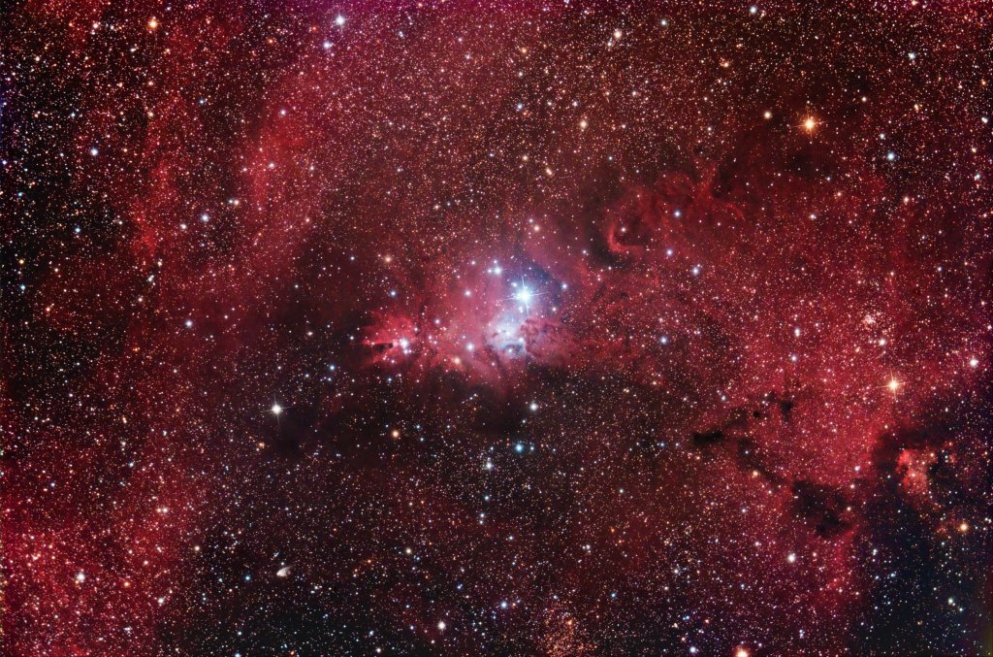DavidACaruso wrote:In the APOD today, November 23, it says how the cone nebula formed remains a mystery. It would appear logical to me to assume that in the middle of the tip of the cone is a bright star, and that the gases in the larger portion of the nebula are flowing towards the outside. The winds produced by the star would cause part of the gas to bunch up and accumulate, which, like putting a rock in a flowing creek, causes the flowing material to produce an empty region that widens the further away from the "rock" (i.e. star) you get. The brightness of the tip of the cone may also be explained possibly by the ionization of the gas in the vicinity of the star.
What IS still a mystery about this 5 year old APOD:
http://antwrp.gsfc.nasa.gov/apod/ap030512.html
is that the apparent source of that wind
is neither the nearby bright B3 giant HD 47887
nor the more distance supergiant S Mon
but rather a totally obscured new star: NGC 2264 IRS

-------------------------------------------------
<<Strange shapes and textures can be found in the neighborhood of the Cone Nebula. These patterns result from the tumultuous unrest that accompanies the formation of the open cluster of stars known as NGC 2264, the Snowflake cluster. To better understand this process, a detailed image of this region was taken in two colors of infrared light by the orbiting Spitzer Space Telescope. Bright stars from the Snowflake cluster dot the field. These stars soon heat up and destroy the gas and dust mountains in which they formed. One such dust mountain is the famous Cone Nebula, visible in the above image on the left, pointing toward a bright star near the center of the field. The entire NGC 2264 region is located about 2,500 light years away toward the constellation of the Unicorn (Monoceros). >>
http://antwrp.gsfc.nasa.gov/apod/ap070509.html
-------------------------------------------------
<<One hypothesis holds that the Cone Nebula is formed by wind particles from an energetic source blowing past the Bok Globule at the head of the cone.>>
http://antwrp.gsfc.nasa.gov/apod/ap051225.html
-------------------------------------------------
<<The massive star NGC 2264 IRS, seen by Hubble's infrared camera in 1997, is the likely source of the wind sculpting the Cone Nebula and lies off the top of the image. The Cone Nebula's reddish veil is produced by glowing hydrogen gas.>>
http://antwrp.gsfc.nasa.gov/apod/ap040529.html
-------------------------------------------------
<<The Hubble telescope's infrared camera has peered into the Cone Nebula, revealing a stunning picture of six babies, Sun-like stars surrounding their mother, a bright, massive star. Known as NGC 2264 IRS, the massive star triggered the creation of these baby stars by releasing high-speed particles of dust and gas during its formative years. The image on the left, taken in visible light by a terrestrial telescope, shows the Cone Nebula, located 2,500 light-years away in the constellation Monoceros. The white box pinpoints the location of the star nursery, which cannot be seen in this image because dust and gas obscure it. The infrared image on the right shows the massive star ? the brightest source in the region ? and the stars formed by its outflow.>>
http://hubblesite.org/newscenter/archiv ... es/1997/16
-------------------------------------------------
<<The star cataloged as NGC2264 IRS is normally hidden from the inquiring gaze of optical telescopes. It resides in the midst of the obscuring gas and dust of a nearby star forming region popularly known as the Cone Nebula. Imaged in penetrating infrared light by the Hubble Space Telescope's NICMOS instrument, this young and massive star was found to be surrounded by six "baby" sun-like stars - all within less than a tenth of a light-year of their "big brother". Astronomers believe that the high speed winds generated by the massive star compressed nearby material causing the formation of the smaller stars in a text book example of triggered star formation. The young suns appear to lie along an otherwise invisible boundary where the high speed gas has collided with the wall of a denser molecular cloud. NGC2264 IRS also seems to be the source of the outflow which created the striking cone shape of the optical nebula.>>
http://antwrp.gsfc.nasa.gov/apod/ap000219.html
-------------------------------------------------
http://www.ipac.caltech.edu/2mass/galle ... 1atlas.jpg

